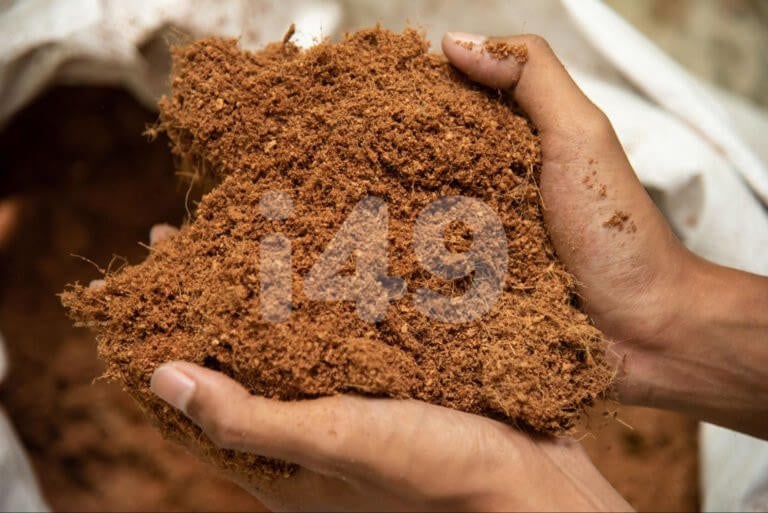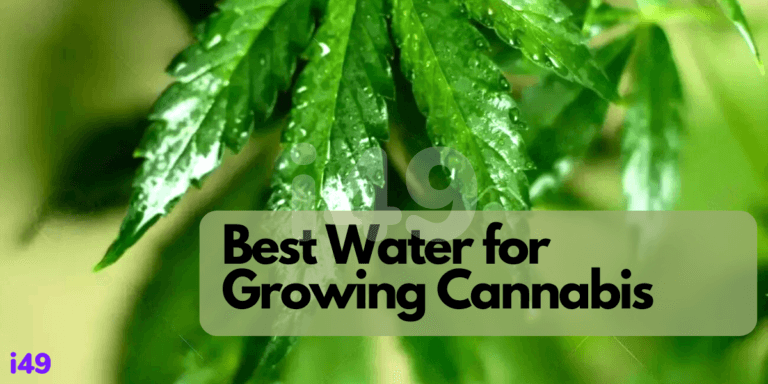When growing weed without soil, it’s solely your responsibility to meet the crops’ nutritional requirements. It’s essential to pick the proper nutrients for coco coir to help your marijuana plants get big and strong.
Coco coir’s unique nature makes it necessary to master the art of nutrient supplementation. You must consider your crops’ needs and the medium’s chemistry while devising a feeding schedule.
Keep reading for a complete guide on nourishing coco coir for abundant weed harvests. We discuss nutrients, fertilizers, and water requirements.
Let’s get started.
Nutrients and fertilizers for coco coir
Along with the light, temperature, and humidity for marijuana, minerals make or break yield size and quality. Does coco coir have nutrients, though?
Coco coir for weed is becoming an increasingly popular alternative to soil and traditional hydroponic systems. This medium consists of coconut fibers ground into a loose substance with excellent drainage and aeration properties. It’s eco-friendly, pH-neutral, and beneficial to crops.
It contains some phosphorus and potassium, but weed needs a palette of other nutrients, making it necessary to supplement. What’s more, coco is high in sodium, which you counter with other minerals.
Which elements should you supplement?
The following coco nutrients are essential for healthy growth:
- Calcium supports the root system and counters the adverse effects of sodium.
- Magnesium helps marijuana turn light into energy through photosynthesis.
- Phosphorus encourages leaf development, stem strength, and bud production.
- Potassium strengthens plant tissue and improves resistance to environmental issues.
- Nitrogen aids amino acids and supports the structural integrity of vegging crops.
- Carbon facilitates foliage and stem development, making cannabis robust.
- Iron helps nutrients travel to the roots and reach the leaves and bud sites.
- Zinc drives metabolic processes and chlorophyll formation for green leaves.
Nitrogen, phosphorus, and potassium comprise the NPK, three macronutrients essential to plant growth. Crops use them in large quantities, but their ratios change throughout the life cycle.
These and a variety of trace minerals help your crop develop. Adding nutrients to coco coir is a must, but you don’t have to acquire each in isolation. Gardening stores and online shops stock ready-made fertilizers with the ideal quantities of all essential elements.
Best nutrients for coco coir
Don’t try to supply the best nutrients for cannabis in coco one by one. Getting a fertilizer with appropriate amounts of each mineral is easier and more accurate. Here you have a choice between organic and synthetic solutions.
Synthetic fertilizers are salt-based, which isn’t a problem in soil. Coco already has plenty of nutrient salts, though. Using this solution can exacerbate the issue and lead to a lockout. When growing weed in coco coir, it’s best to go green.
Organic nutrients for cannabis draw all minerals from natural sources, like manure, kelp, and soy. They give you the convenience of a pre-mixed nutrient solution without the risk of oversaturating the coco with salt.
Note: Buy a specific fertilizer for each growth stage. The best nutrients for big buds change between vegging and flowering.
In a nutshell, get a clean and organic solution without plenty of salt. Your coco coir nutrient schedule requires a CalMag supplement to help the roots absorb minerals.
Coco for cannabis: Schedule and feed chart
Feeding marijuana is similar in all media, but coir also demands a steady influx of calcium and magnesium. This coco for cannabis feed chart displays approximate amounts of macronutrients and CalMag in each growing stage. The exact NPK amounts vary between manufacturers.
| CalMag | Nitrogen | Phosphorus and potassium | |
| Seedlings (week 1) | 0.17 fl. oz./gallon | Medium | None |
| Early vegging (week 2–5) | 0.07 fl. oz./gallon | High | None |
| Late vegging (week 5–9) | 0.08 fl. oz./gallon | High | Low |
| Early flowering (week 1–4) | 0.07 fl. oz./gallon | Medium | Medium |
| Late flowering (week 4–10) | 0.05 fl. oz./gallon | Low | High |
Of course, this table is a guide, not a substitute for knowing your plants’ needs. Watch for nutrient burn, lockout, and deficiency, and adjust your feed accordingly. Provide fewer nutes if growing from autoflowering weed seeds to accommodate their compact size and short lifespan.
Watering cannabis in coco coir
Coco coir nutrients reach your plants through the water. The moisture also nourishes the roots and encourages their expansion. Since this medium drains quickly, you should shower crops generously and regularly.
The first principle is to soak the entire substrate. This fibrous medium carries minimal risk of overwatering, and saturation prevents salt buildup and nutrient burn.
As a rule, provide enough aqua to see 10–20% runoff. Use this principle to determine the optimal water amounts and shower frequency.
Regular watering works best, but not through constant drip systems. Generous runoff maintains root zone health, so supply moisture daily or every other day.
Tip: Provide H2O twice daily for three days after transplanting your crops to a bigger pot. Then resume regular waterings.
Besides quantity, water quality determines your success rate. Let’s look at the optimal PPM, EC, and pH for cannabis in coco.
pH of coco coir for cannabis growing
pH for cannabis affects nutrient availability. This chemical concept refers to the ‘power of hydrogen’ and measures the alkalinity or acidity of your water, medium, and fertilizer.
The best ph for cannabis in coco is 5.5–6.5, and going outside that range can cause lockout or deficiencies.
Unlike the pH in soil, which fluctuates based on your area, coco coir is generally well-balanced. It typically has a pH value of 5.7–6.5, so if you see an imbalance, the water and nutrients are the likely culprits.
Measure the pH regularly using drips or a manual meter. Check the value of the pure water before adding nutrients, the H2O-nutrient blend, and the runoff at the tray. That way, you can tell whether the coco, liquid, or fertilizer is too acidic or alkaline.
If you notice an imbalance, flush your coco with pH-neutral water before resuming the regular coco for cannabis nutrient schedule. If your H2O source is an issue, use a pH-Up or pH-Down treatment with future showers.
PPM & EC for coco coir
Besides pH levels, the best water for growing cannabis must meet PPM and EC criteria.
PPM is short for ‘parts per million’ and describes the mass of chemicals and contaminants per liquid unit. In the US, tap water contains 350 ppm. When you grow cannabis, you add nutrients to the H2O and increase this value.
The optimal PPM for coco coir is 800–900 in vegging and 1000–1100 in flowering. Always measure it before watering the medium and repeat the process with the runoff. If the latter number is higher, you might be dealing with salt buildup around the roots.
EC stands for ‘electrical conductivity’ and describes the salinity of a water sample.
Salty water can inhibit nutrient uptake. For this reason, EC is easier to manage with organic nutrients for coco coir. Plus, these fertilizers have microorganisms that provide a buffer against fluctuations.
The target EC values for marijuana are 1100–1500 in vegging and 1100–1600 in flowering. The best way to gauge it is by measuring the runoff EC, as this figure reflects the salinity inside the medium. If it’s too high, flush the coco with non-saline water.
Feeding for abundance
Many growers shy away from coir because of its unique feeding and watering requirements. As this guide has shown, coco cultivation is easy once you understand its starting chemistry.
This medium produces big plants that develop quickly and yield heaps of sticky buds. Why say no to that? Pick a suitable coco coir fertilizer and water source, and your cultivation journey is straightforward and prolific.
Ready to try this weed-growing technique? Check out our shop to buy marijuana seeds and set yourself up for success with top-tier genetics.
FAQs about coco coir
Here are some common community questions about the watering practices and best cannabis nutrients for coco.
Does coco coir have nutrients?
When comparing coco vs. soil, the former appears scarce in essential nutrients. It contains some phosphorus and potassium, but not enough for blooming plants. After flushing out the sodium, you need to supplement it with cannabis-specific minerals.
When should I start giving coco coir nutrients?
When growing in soil, the medium already contains everything seedlings need to succeed. You only start supplementing in the vegetative stage. If using coco for cannabis, the feed schedule begins right after germination. Even baby plants need small amounts of fertilizer.
Should I water coco every day?
Cannabis plants in coco coir do well with a shower every other day. Hot and well-ventilated areas make H2O necessary at more frequent rates, as the medium needs to remain moist. Transition to daily watering if there’s less than 10% runoff at the bottom of the pot.














